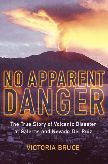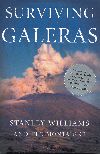aprilheader.html

Geomedia
The
Geotimes Web site now offers each month's book reviews, list of new
books, book ordering information and recommended Web sites.
Look for new maps in the print edition. This site is in development. Please
send any suggestions to geotimes@agiweb.org
BOOK
REVIEWS by Wally Johnson

No Apparent Danger
by Victoria Bruce
HarperCollins, New York (2001). ISBN
0-060-19920-2. Cloth, $26. Release date:
April 2 |

Surviving Galeras
by Stanley Williams and Fen Montaigne
Houghton Mifflin, New York (2001). ISBN
0-618-03168-5. Cloth, $25. Release date:
April 7.
|
Two books from different publishers on a small but harrowing volcanic
eruption in South America are being released within days of each other
this month — indicative, one assumes, of some behind-the-scenes jostling
to take advantage of the “first in, best dressed” rule in publishing.
No Apparent Danger and Surviving Galeras tell the tale
of the Jan. 14, 1993, crater eruption of Galeras Volcano, near Pasto city
in southern Colombia. The violent explosion killed six volcanologists from
Colombia, Britain and Russia, and three Colombian tourists. The eruption
was geologically inconsequential in terms of its size, and the number of
people killed was small compared to fatality counts from other volcanic
eruptions. Thus both books, rather than emphasizing the eruption as a geological
event, focus instead on the significant human drama surrounding the tragedy.
They are both of similar size and style and well written, and both authors
are American — but there the similarities end.
The real fascination of this double release is that each book tells
a different story of the events surrounding Galeras.
Surviving Galeras is by Stanley Williams, a volcanic-gas geochemist
and academic, and co-author Fen Montaigne. As one of the scientists attending
an international volcano conference being held in Pasto that week in 1993,
Williams led a group of field trip participants into the Galeras crater.
He survived the eruption, but only by the skin of his teeth, incurring
horrendous physical injuries. He endured multiple operations, including
brain surgery to remove shattered skull fragments. A heroic group led by
Marta Calvache of the Pasto Volcano Observatory and Patty Mothes, a U.S.
volcanologist based in Quito, Ecuador, rescued him from the crater.
Surviving Galeras is a personal, at times egocentric, account
of the eruption and the events preceding and following it, supplemented
by neat vignettes on famous eruptions, famous volcanologists, volcanoes
and climate change, and so forth. Williams’ narrative is both an explanation
of events and a defense of his actions on Galeras. It seems in large part
a cathartic exercise aimed at ridding Williams of the emotional devils
that have haunted him since that awful day on the volcano.
The final chapter is poignant, for we read of the price Williams has
paid: the demise of a high-profile research career in volcanology, a broken
marriage, the derailing effects of “a volatile mix of powerful seizure
medications and antidepressants,” and failure of the “brakes on my bad
behavior” (he confesses to being impatient and aggressive). Williams also
records the visits he made to some of the families who lost loved ones
on Galeras. These visits evidently were important to him for psychotherapeutic
purposes, but the reader may well feel intrusive when reading about the
details of personal grieving and pain of the bereaved.
The author of No Apparent Danger is science writer and geology
graduate Victoria Bruce. She is not a volcanologist and was not directly
involved in the 1993 Galeras event, and takes the viewpoint of an “outsider.”
She was interested initially in simply writing up the Galeras story as
she knew it from newspaper articles and media interviews, but subsequently
became more curious, if not driven, about a “story behind the story.” Bruce
interviewed many people in the United States and South America about what
happened on Galeras and, following the established traditions of investigative
journalism, is uncompromising in the presentation of her widely researched
results.
The first third of Bruce’s book deals with another high-profile volcanic
eruption in Colombia — that of Nevado del Ruiz in 1985, when a small summit
eruption melted snow and ice, generating devastating mudflows that led
to the deaths of 23,000 people downstream. The story she tells is of local
officials not heeding warnings about the threat of mudflows, and how the
large death toll otherwise might have been avoided. Bruce uses the Ruiz
eruption to introduce volcanologists who appear in the main part of her
book. This includes Williams who, after the 1985 eruption, had predicted
a catastrophic eruption at Ruiz that did not eventuate, leading to unnecessary
consternation among the already stressed and traumatized people who live
on the volcano. This is the start of what, by the end of the book, turns
out to be an unrelenting pursuit to describe Williams’ actions and behavior.
Bruce raises several important issues, such as how effectively the crater
party kept in radio contact with the Pasto volcano observatory, and how
appropriate the party’s safety precautions and protective gear were (Williams
is reported to have mocked one of the party for wearing safety clothing).
She also tackles the issue of whether sufficient attention was paid before
the crater visit to characteristic seismic signals (long-period codas in
the shape of screws, or tornillos) that were recorded at the Pasto observatory.
Should the earthquake records have been interpreted as seismic precursors
to the eruption? Then there is Williams’ claim in the ensuing media coverage
— did Williams seek out that publicity? — that he alone survived the eruption,
when clearly others did too. Williams expresses regret for this assertion
in his own book. And so the stream of revelations goes on …
Some good has come from the Ruiz and Galeras tragedies and other volcanic
crises of the 1990s. The International Association of Volcanology and Chemistry
of the Earth’s Interior (IAVCEI), following the Ruiz eruption, produced
two public-awareness videos on volcanic hazards and risk. One of these
was shown to communities on Pinatubo volcano in the Philippines and is
thought to have hastened the safe evacuation of thousands of people before
the volcano’s major 1991 eruption. After Galeras, IAVCEI established a
set of safety guidelines for working on volcanoes and, in 1999, published
a set of professional protocols for scientists to use during volcanic crises
(see Bulletin of Volcanology, vol. 60, pp. 323-334).
Few volcanologists enter the craters of volcanoes without a sense of
excitement and wonder. But only a small minority adopt a fatalistic, devil-may-care
(if not “death-wish”) approach to their work. The majority of volcanologists
exercise care and good judgment, apply stringent safety standards and are
disciplined in ego self-management. Hopefully the IAVCEI safety guidelines
and protocols eventually will be adopted by that small number of volcanologists
who ignore what basically are common-sense practices and who give the profession
a bad name. The message from this fascinating couplet of books is that
we need to avoid tragedies like the one that happened at Galeras in 1993.
Johnson is chief of the Division of Geohazards
and geomagnetism in the Australian Geological Survey Organisation. Between
1991 and 1999, he was secretary general of the International Association
of Volcanology and Chemistry of the Earth’s Interior.
On the
Web
www2.nature.nps.gov/grd/
Take a tour of one of our nation’s national parks — or at least a virtual
tour — through the Park Geology section of the National Park Service’s
Web site. The “tour” section offers information on the geology of each
park, in addition to wildlife, visitor information and a photo gallery.
“Tours” are grouped according to geologic formation or history. A section
on plate tectonics provides links to parks grouped under subheadings that
pertain to North America’s tectonic history. For example, under Ocean-Continent
Subduction Zones, you will find Active Volcanic Arcs, Ancient Arcs, Low-Angle
Subduction Zones and Accretionary Wedges. Each subheading is followed by
a list of links to National Parks that fall within those geologic regions.
Attaching a known location to an abstract geologic concept makes this Web
site particularly useful, and the site could make a good classroom tool.
Laura Wright
On the
shelf
Bibliography of the Earth Sciences for the Horn of Africa: Ethiopia,
Eritrea, Somalia and Djibouti 1620-1993, edited by Jon E. Kalb,
Dejene Aneme, Ketema Kidane, Mohamed Santur and Afifa Kechrid. American
Geological Institute (2000). 470 p. ISBN 0-922152-53-5. Paperback, $74.95.
Climate for Change: Non-State Actors and the Global Politics of
the Greenhouse by Peter Newell. Cambridge University Press (2000).
222 p. ISBN 0-521-63250-1. Cloth, $69.95.
Climates: Past and Present, edited by M.B. Hart. Geological
Society (London) (2000). 224 p. ISBN 1-86239-075-4. Illus. Cloth, $108.
Coastal and Estuarine Environments; sedimentology, geomorphology
and geoarchaeology, edited by K. Pye and J.R.L. Allen. Geological
Society (London) (2000). 428 p. ISBN 1-86239-070-3. Illus. Cloth, $142.
Continental Tectonics, edited by C. Mac Niocaill and P.D.
Ryan. Geological Society (London) (2000). Special Publication 164. 350
p. ISBN 1-86239-051-7. Illus. Cloth, $125.
Currents of Change by Michael H. Glantz. Cambridge University
Press (2001). 248 p. ISBN 0-521-78672-X. Illus. Paperback, $24.95.
Where
to order
Also
visit AGI's Earth
Science World Bookstore to search Amazon.com.
American Association
of Petroleum Geologists, P.O. Box 979, Tulsa, Okla. 74101-0979. Phone:
(800)364-2274. Fax: (918)560-2652. E-mail: bookstore@aapg.org.
Cambridge University
Press, 110 Midland Ave., Port Chester, N.Y. 10573-4390. Phone: (800)872-7423.
Fax: (914)937-4712. WWW: http://www.cup.org.
The Geological Society,
(London), Unit 7, Brassmill Enterprise Centre, Brassmill Lane, Bath BA1
3JN, U.K. Phone: 44 01225 445046. Fax: 44 01225 442836. Publications may
be ordered from AAPG.



